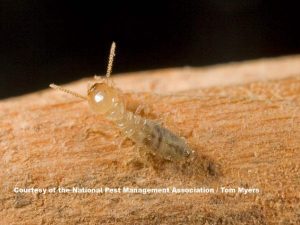Q: Can you describe the life cycle of termites?
Q: How do you identify termite infestations?
A: Mud/shelter tubes are usually the first visible sign of an infestation. Swarmers can often be found in mass in window sills and expansion joints.
Q: Can you list some tips to help prevent an infestation?
A: Have preventative termite treatment done, maintain existing termite policies, and have your home inspected yearly. Keep wood stored above the ground or away from structures. Also, remedy any moisture issues underneath or around the outside of your home or structure.
Q: What is the treatment process, and most important steps?
A: Treatment varies greatly depending on the structure of the building and how it’s constructed; if there is a slab; if there is any veneer; and the type of flooring that is in the building. We want to ensure we get to any and all gaps and are hitting every part, going deep into the soil. Termites are sneaky and will come through teeny tiny cracks.
Being thorough is the most important part. Another important part is the initial inspection, so you know what kind of damage you’re dealing with and the best way to treat it, along with being specific when notating.
The process of an inspection goes like this: we inspect, draw a graph, mark what we find, write down treatment specs, give a price and then schedule the service. Once the service has been completed, we’ll issue quality inspections as well as yearly termite inspections. Many people don’t understand the purpose of those yearly inspections. We’re looking for signs of active termites and things that could possibly attract termites. And, if active termites are found while a home is under contract, we’ll treat it again and repair the damage.
Don’t see a question we have listed? Contact us and we will get you an answer!
If you suspect you might have termites, or if you want to ensure you and your home are protected, give us a call today! Remember, “The Bug Stops Here!”



